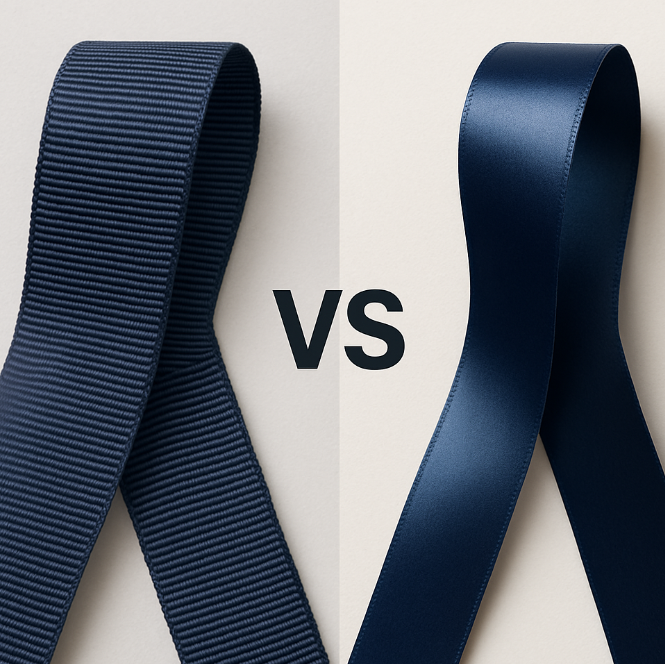You’re crafting, decorating, or wrapping, and you need ribbon. Two names keep popping up: grosgrain and satin. But which one is right for your project? If you’re searching “grosgrain vs satin,” “satin vs grosgrain ribbon,” or “difference between grosgrain and satin ribbon,” you’ve landed in the right place. Let’s cut through the confusion and dive into the distinct personalities of these two popular ribbon stars.

Grosgrain Ribbon vs Satin Ribbon: The Quick Comparison
| Feature | Grosgrain Ribbon | Satin Ribbon |
|---|---|---|
| Texture | Pronounced crosswise ribs, firm, crisp | Smooth, flat, luxuriously soft |
| Sheen | Subtle, matte or slight luster | High, reflective, glossy |
| Durability | Excellent (fray-resistant, sturdy) | Moderate (snags/frays easier) |
| Structure | Holds shape well, less flexible | Fluid drape, more flexible |
| Best For | Edges, structure, outdoors, grip | Elegance, drape, softness, luxury |
Understanding Grosgrain Ribbon: The Sturdy & Textured Workhorse
- The Look & Feel: Grosgrain’s signature is its distinct ribbed texture running crosswise (weft-wise). Run your finger across it – you’ll feel those raised ridges. It has a crisp, firm handfeel and offers a subtle sheen, ranging from matte to a soft luster, but never intensely shiny.
- Key Strengths:
- Durability Champion: Its tightly woven, ribbed structure makes grosgrain highly resistant to fraying. Cut edges stay neat longer, often without needing sealing (though sealing is always good practice).
- Shape Keeper: Grosgrain holds its shape beautifully. It resists curling and stays flat, making it ideal for applications where structure matters (like hat bands, bag handles, or crisp bows).
- Grip & Traction: The textured surface provides grip, excellent for tying secure knots, wrapping gifts that stay put, or adorning items that might be handled.
- Weather Friendlier: Generally performs better than satin outdoors or in humid conditions due to its tighter weave and less moisture-absorbent nature (depending on fiber content).
- Common Uses: Hair bows & accessories (holds shape), gift wrapping (sturdy bows, stays tied), crafts requiring structure (ornaments, bookmarks), clothing trims (belts, corsets, edges), military & award ribbons, high-quality pet collars/leashes.
Understanding Satin Ribbon: The Epitome of Smooth Elegance
- The Look & Feel: Satin ribbon is all about luxurious smoothness and a high-gloss sheen. Its surface is flat and reflects light beautifully. It feels soft and fluid to the touch, draping gracefully.
- Key Strengths:
- Luxurious Aesthetic: Nothing says elegance, sophistication, or celebration quite like the deep shine of satin ribbon. It instantly elevates any project.
- Beautiful Drape: Satin flows and drapes softly, creating fluid bows and graceful accents. It’s perfect where a softer, romantic look is desired.
- Variety of Finishes: Comes in different “faces” like standard satin (shiny on one side, dull on the back), double-faced satin (shiny both sides), and stretch satin.
- Considerations:
- Fraying: The smooth weave means satin is more prone to fraying than grosgrain. Cutting with sharp scissors and sealing the ends (with a flame or fray check) is highly recommended.
- Snagging: The delicate surface can snag more easily on rough surfaces or sharp objects.
- Structure: Satin bows can sometimes lose their shape or droop more easily than grosgrain bows, especially over time or in humidity. It’s less rigid.
- Common Uses: Wedding decorations (bouquets, chair sashes, aisle runners), luxurious gift wrapping & presentation, hair accessories (soft ties, flowing details), lingerie and special occasion garment trims, elegant crafts (jewelry, favors), high-end event decor.
Grosgrain vs Satin: The Head-to-Head Breakdown
- Texture:
- Grosgrain: Ribbed, textured, crisp.
- Satin: Smooth, flat, silky.
- Sheen:
- Grosgrain: Subtle, matte to low-luster.
- Satin: High, glossy, reflective.
- Durability & Fraying:
- Grosgrain: Winner. Significantly more fray-resistant and sturdy.
- Satin: More delicate, prone to fraying and snagging. Requires careful handling and sealing.
- Structure & Drape:
- Grosgrain: Holds sharp creases and shapes well. Less flexible. Provides grip.
- Satin: Drapes fluidly and softly. More flexible. Creates flowing bows.
- Best Suited For:
- Grosgrain: Projects needing durability, structure, clean edges, grip, or a classic/textured look (hair accessories, gift wrapping, crafts, outdoor use, trims).
- Satin: Projects prioritizing luxury, elegance, a high-gloss finish, and soft drape (weddings, formal gifts, special occasion decor, lingerie, soft hair ties).
So, Which Ribbon Should YOU Choose? The Simple Cheat Sheet
- Choose Grosgrain Ribbon If:
- You need durability and fray resistance.
- You want crisp bows that hold their shape.
- Your project involves outdoor elements or handling.
- You need grip for tying secure knots.
- You prefer a textured, classic, or matte look.
- You’re trimming edges or making structural elements.
- Choose Satin Ribbon If:
- You want maximum shine and a luxurious feel.
- You need soft, flowing drape for bows or decorations.
- Elegance and sophistication are the top priorities (e.g., weddings, formal events).
- Your project is purely decorative and protected from snags.
- You’re wrapping delicate gifts or creating heirloom items.
The Verdict: It’s About Purpose, Not “Better”
There’s no single “best” ribbon between grosgrain and satin. They excel in different arenas. Grosgrain is your dependable, textured, durable workhorse. Satin is your glamorous, flowing, elegant showstopper.
Next Time You Ask “what is the difference between grosgrain and satin ribbon”…
…ask yourself: What does this project demand? Crisp structure and longevity? Choose grosgrain. Liquid shine and soft drape? Choose satin. Often, having both in your craft arsenal is the real winning strategy!
By understanding these core differences – texture, sheen, durability, drape, and best-use cases – you can confidently select the perfect ribbon every time, ensuring your creations look stunning and function flawlessly. Happy crafting, decorating, and wrapping!



